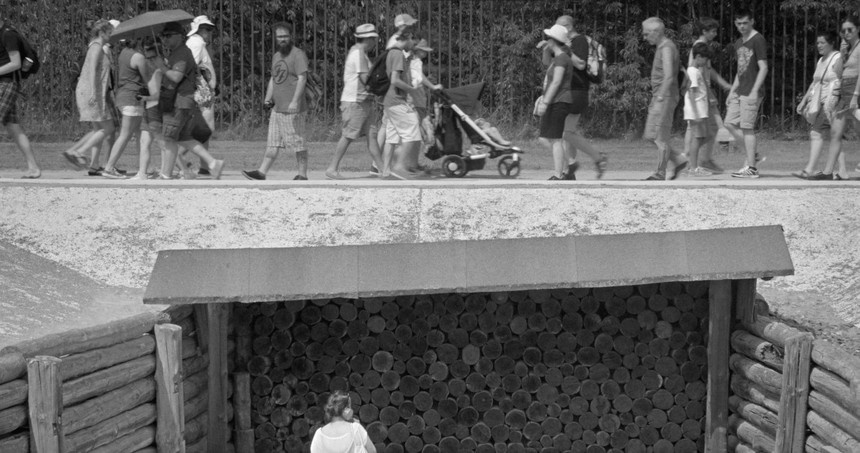Venice 2016 Review: AUSTERLITZ, Sergei Loznitsa Shows the Horrors of the Camps Didn't End with WWII

Sergei Loznitsa’s Austerlitz very nearly drew a bad review from me yesterday, as I was still reeling from Malick’s Voyage of Time: Life’s Journey. That was largely due to the fact that the Ukranian documentarean's film initially felt like a similarly self-indulgent piece that slowed time into an unsufferable lethargy. Fortunately, Loznitsa’s work always somehow seem to come good in the end.
At first, Austerlitz begins amidst a sea of people (just as Maidan did), and we observe them as if from the bushes at a frustratingly inert pace. Put frankly, the sensation this creates is not unlike the dissatisfaction of being in an endless queue at a theme park. Except we’re not at a theme park, we’re at the gates of one of the most unhallowed places on earth – a Nazi concentration camp where an estimated 70,000 people were held and an unknown number tragically ended their days.
It is this tension between tourist attraction and awful atrocity which this misanthropic documentary painfully tears apart as the documentary starts to get interesting. The absurd antagonism of what we see the visitors doing begins to become clear when the camera assumes Loznitsa’s trademark static pose before a gate, which has the words “arbeit macht frei” woven into its metalwork.
Immediately this iconic sign proves to be something of a flame to the moth, and like a flaneur we begin to judge the passing tourists. They are so confrontationally laid before our eyes, and the oddities of their behaviour are so enhanced by a carefully heightened diegetic soundtrack, it is hard not to develop negative feelings towards them. A barrage of cameras and iphones compete for a killer profile picture. Even a Jewish man stops to clutch at the gate’s bars, as if that were an image worth recreating. You begin to wonder with horror whether a comparable gate today might not read, “selfies macht frei.”
The next thing you come to question the most is the tourist’s choice of t-shirts (on what you might have thought would be a respectful visit). At first it seems just incidental ironic that a punky woman might wear a t-shirt with one arrow pointing up labelled “The Man,” and one pointing down titled “The Legend.” But before long, the decisions of one man to wears a t-shirt emblazoned “Fuckin’ 99 Problems” and of a woman to wears one saying “Just Don’t Care” comes to demand much greater scrutiny.
This sort of stomach-turning irony continues throughout, as Loznitsa takes aim at various busy thoroughfares in the camp. Nevertheless, the way each scene lingers and out stays its welcome at times definitely causes your mind to wonder. Except I suppose that is exactly the documentary’s accusatory point: as a generation, we seem almost incapable of stopping and paying the respectful attention that this camp deserves.
So just as with Maidan, at some point the cleverness of what the director is doing starts to sink in. Absurd and obscene as they are, the parallels he creates between the visions of what we see today and the visions of what we might have seen in under the Nazis slowly begin to present themselves. And this is something definitely encouraged by Austerlitz’s vintage-feeling, black-and-white footage.
The way truck loads of tourists and guided tours ebb and flow round the camp definitely comes to seem not unlike how you would have imagined Holocaust prisoners were shuffled round too. Certainly the volume of people helps, and brings the horror to life in your imagination. Soon the mind’s eye also begins playing tricks, and the odd selfie stick begins to resemble a guard’s casually hostile rifle. You stop almost being able to look at the images in the same way.
The horror of the tourists' the actions and behaviour is never fully lost, though. In what was no doubt a very selective editing process, almost none of the visitors seem to be at all affected by the gravity of the “attraction” they’re visiting - except for about perhaps three minutes of footage that were allowed to make it in towards the end of Austerlitz’s 94 minutes. And everyone seems in such a continual rush, as if they a shepherded round whilst they laugh, flirt and eat.
What’s more, the guides seem almost upbeat, just like any other walking guide you could get anywhere else in the world. But the documentary does have this wonderful tension where the little known facts the guides deliver do almost allow Austerlitz to fulfil an didactic purpose. It's just that there is always an antithetical force seeming to prevent that, as one guide begins to talk noisily over another in this almost industrialized chain of tourism. One guide even tells her group that, "if you’re really quick we can have an even longer break." Another sounds a bit like he’s unintentionally imitating Troy McClure from The Simpsons.
Perhaps, in truth, this is all uplifting evidence that life goes on. But the point is spelt out that the camp is now supposed to act as a reminder so that nothing like this would ever happen again. Upon leaving, not one individual seems changed by what they have seen, and it feels almost genuinely upsetting. Nevertheless, if you’ve been a fan of Loznitsa’s previous work, the troublingly Austerlitz should be for you.






